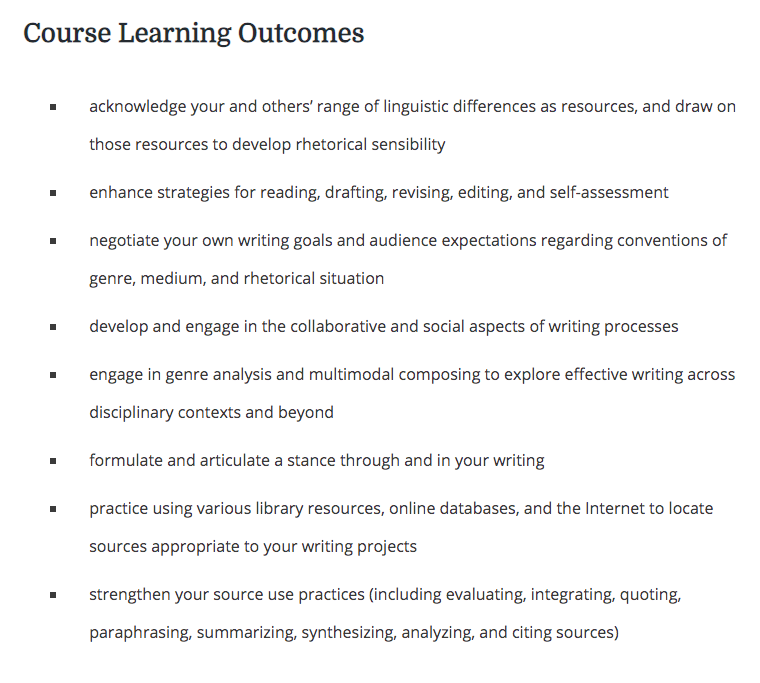
Opinion Editorial
The assigned opinion editorial struck me with a learning curve. What a genre! It took me two vastly different drafts to achieve a finished product. I was finished when I came to understand the importance of bending towards my audience. I had never written so purely of my own opinions, so my tendency led me to write a sort of in between of a persuasive essay and a dense list of talking (see Draft 1 on page 1 of “Drafts”). It was the feedback, first from my peers and ultimately from my professor that delivered me to a successful paper. Further, in reading my peers work I saw the op-ed from the reverse perspective, as a consumer, and slowly began decoding the “op-ed genre.” I suddenly realized what it meant to “negotiate my own writing goals” with the “audience expectation” and I realized the expectation was constructed through the genre. I realized that in the context of an op-ed, there is something pleasingly persuasive about the palatable. Immediately I was immersed in the process of revision; in sense the revision was like “strengthening my source use.” For my rewrite, I drew upon my original paper to determine the most understandable, and poignant facts- this was my source and I was extracting only the most compelling. This too was revision, but a revision of research. I thought in my first draft that I had chosen the most relevant arguments, and yet even these were too much. Certainly, I learned to articulate a stance, expressing it from two perspectives. The louder claim was that the animal industry is wrong because of its atrocious environmental impact, and the undertone echoed values of animals rights. Though I learned a lot writing this paper, there was much to be developed still.
On the first page under “Opinion editorial”, you will encounter the final draft of my opinion editorial “Slaughter House 55: An Environmental Appeal.” I placed my reflection on the 2nd page under “Opinion Editorial” to offer you a deeper understanding of my process.
Visual Essay
Because of the awareness I had gained through my op-ed, I was able to design my visual essay with purposefully. The result was an intense digital image, or as the cool kids say, “meme,” promoting the idea of animal sentience, in likening animals to humans (see the image on page 1 of “Visual Essay”). My stance was clear and further articulated in my reflection, along with the explanation of the decisions I referred to above (see page 2 of “Visual Essay”). I was also able to read the intentionality in the work of my peers whether or not they had articulated these decisions in words. From doing this, I also furthered my understanding of an audience- of who is looking at my piece, how they are looking at it, what will they understand immediately and what will thoughts will they continue to “chew” on. I was then able to explain how I constructed the visual essay with these conceptions in mind (see Audience Strategy on page 3 of “Visual Essay”). For this essay I did not research, but I explored a genre that I never thought to dabble in. And, I had fun.
I also included a draft of both the visual work, and two drafts of the written reflection for this piece which you can see on page 2 of “Drafts.”
Research Critical Analysis
The research critical analysis required the employment of all the skills I acquired this semester. As I discuss more in my assessment paper “Self-Referential: Assessment in Detail” (under the second heading on the page “Retrospectating”) it was a fusion of author and audience, the product of a critical reader who can express interpretation eloquently in writing. Hence I achieved both simultaneously and the victory was therefore extra sweet, albeit not immediate. I actually recorded the most revision for this paper (you can see three revisions on page 3 of “Drafts”). As I got caught up in awareness, hyper-awareness perhaps began to morph into obsession. Socially, I engaged with my peers, my professor, and the writing tutor (and hero) Molly for advice. I did research in a way that was warranted by the genre of my paper as opposed to diving blindly without direction into all possible discourse relating to public housing. You can read the final version of my research critical analysis, “NYCHA: Exacerbated by Time” on page 1 of “Research Critical Analysis”, accompanied by the works cited page. On page 2 I included a short reflection piece.
Blog Posts
The blogposts helped me engage with my peers, immerse in varied media of multiple genres. Each one occupied a unique rhetorical situation which I was able to judge critically and consistently. These also taught me about incorporating quotes to show how something is constructed, be it an argument in the writing or a real-life circumstance analyzed in writing.
Retrospectating
Here I practiced looking at my own work through a critical lens, performed analysis of my work in terms of the course learning outcomes, and discussed the purpose and meaning of writing. “A Sketch” is teaser and perhaps more introspective than the full paper, “Self-Referential: Assessment in Detail.” They can both be found on the page “Retrospectating” (which is a word I made up).

